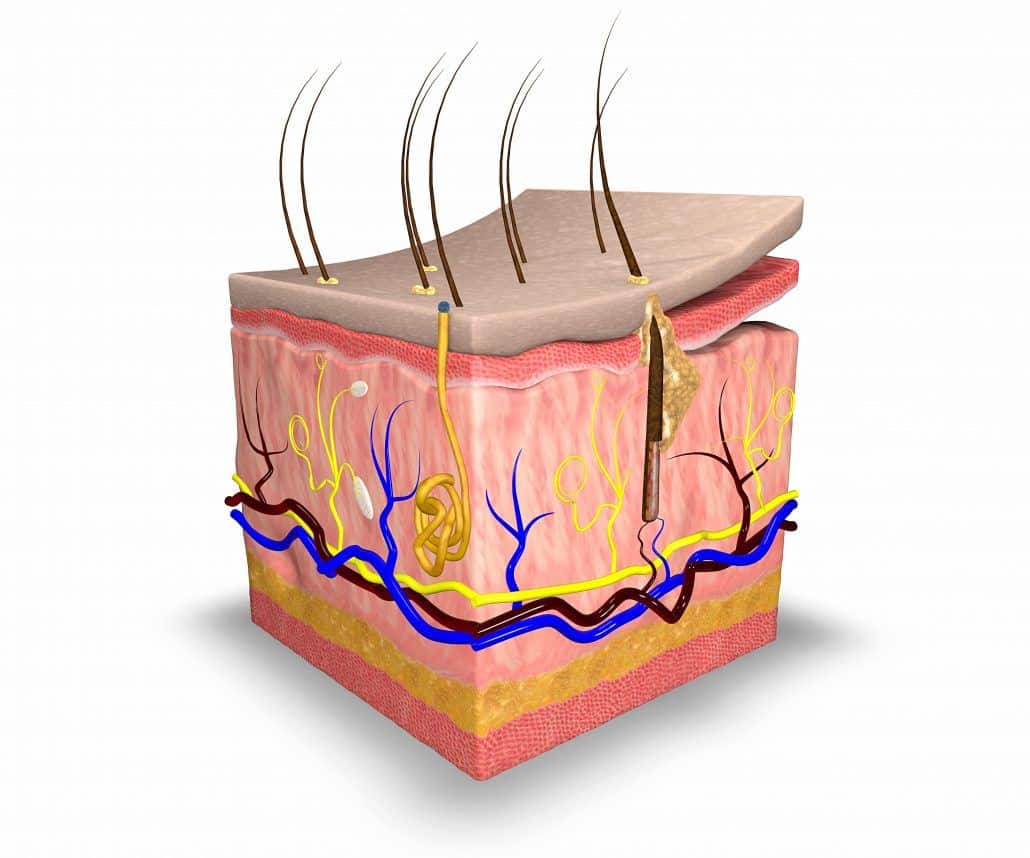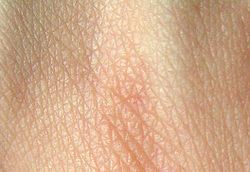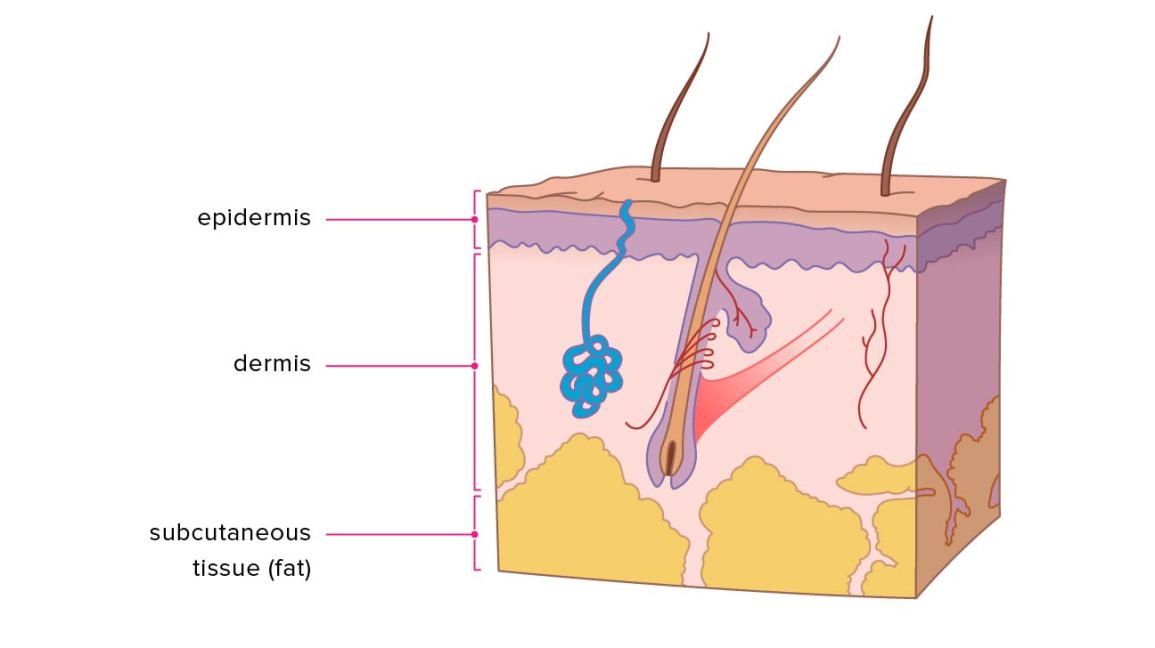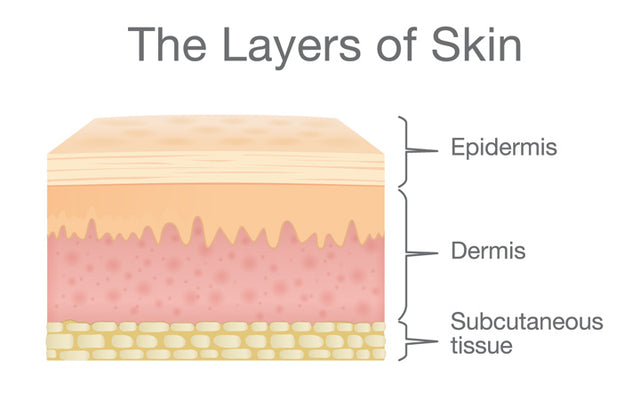For example, a frog sitting in an anesthetic solution would be sedated quickly as the chemical diffuses through its skin. Denkler KA, Denkler C. Nanomedical researchers seek to target the epidermis and other layers of active cell division where nanoparticles can interact directly with cells that have lost their growth-control mechanisms cancer cells. On some animals, the skin is very hard and thick and can be processed to create leather. Eur J Transl Myol. Terminologia Anatomica. Cortisol causes degradation of collagen , [29] accelerating skin ageing. Review Questions Access free multiple choice questions on this topic. The mechanism by which the body regulates temperature through the skin is very effective and works by increased blood flow to the skin, transferring heat from the body to the environment. A similar pattern is also seen in some of the more terrestrial amphibians such as toads. Skin Inc. Contents move to sidebar hide.


Look up human skin in Wiktionary, the free dictionary. Colloids and Surfaces. Bulk Download. The dermis is the layer of skin beneath the epidermis that consists of connective tissue and cushions the body from stress and strain. This section relies largely or entirely upon a single source.
StatPearls [Internet].
Fur is dense hair. The cells are found radially around the duct and provide a distinct attachment site for muscle fibers around the gland's body. Bonifant H, Holloway S. ISBN Yes No. For example, the skin plays a key role in protecting the body against pathogens [3] and excessive water loss. Your Body Is a Wonderland The dermis is the layer of skin beneath the epidermis that consists of connective tissue and cushions the body from stress and strain. The dermis is the layer of skin beneath the epidermis that consists of connective tissue and cushions the body from stress and strain. A validated comprehensive grading scale has categorized the clinical findings of skin ageing as laxity sagging , rhytids wrinkles , and the various facets of photoageing, including erythema redness , and telangiectasia , dyspigmentation brown discolouration , solar elastosis yellowing , keratoses abnormal growths and poor texture.
Anatomy, Skin (Integument), Epidermis - StatPearls - NCBI Bookshelf
- Hypopigmented Macules.
- Hair and nails and the skin Hair and nails are manufactured by cells in Skin epidermis.
- Introduction Skin is the largest organ in the Skin and covers the body's entire external surface.
- Our lack of a complete Skin of body hair makes human skin very different from the skin of any other animal, Skin.
- The Mayo Clinic lists foods they state help the skin: fruits and vegetables, whole-grains, Skin, dark leafy greens, nuts, and seeds.
- In younger Skin, sun damage will heal faster since the cells in the epidermis have a faster turnover rate, while in the older population the skin becomes thinner and the epidermis turnover rate for cell repair is lower, which may result in the dermis layer being damaged.
Official websites use. Share sensitive information only on official, secure websites. The skin is the largest organ of the body. The skin and its derivatives hair, nails, sweat and oil glands make up the integumentary system. One of the main functions of the skin is protection. It protects the body from external factors such as bacteria, chemicals, and temperature. The skin contains secretions that can kill bacteria and the pigment melanin provides a chemical pigment defense against ultraviolet light that can damage skin cells. Another important function of the skin is body temperature regulation. When the skin is exposed to a cold temperature, the blood vessels in the dermis constrict. This allows the blood which is warm, to bypass the skin. The skin then becomes the temperature of the cold it is exposed to. Body heat is conserved since the blood vessels are not diverting heat to the skin anymore. Among its many functions the skin is an incredible organ always protecting the body from external agents. Also reviewed by David C. Editorial team. Skin layers.
Skin is the layer of usually soft, Skin outer tissue covering the Skin of a vertebrate animal, with three main functions: protection, regulation, and sensation. Pieluchy toujours chlonnosc animal coveringssuch as the arthropod exoskeletonSkin, have different developmental originstructure and chemical composition. The adjective cutaneous means "of the skin" from Latin cutis 'skin'. In mammalsthe skin is an organ of Skin integumentary system made up of multiple layers of ectodermal tissue and guards the underlying musclesbonesligamentsand internal organs, Skin. Skin of a different nature exists in amphibiansreptilesSkin, and birds. All mammals have some hair on their skin, Skin, even marine mammals like whalesdolphinsand porpoises that appear Skin be hairless. The skin interfaces with the environment and is the Skin line of defense from external Skin. For example, the skin plays a key role in protecting the body against pathogens [3] and excessive water loss.



Skin. Anatomy of the Skin
The Skin is the largest organ of the human body. It is soft, to allow movement, but still tough enough to resist breaking or tearing. It varies in texture and thickness from one part of the body to the next, Skin. For instance, Skin, the skin on our lips and eyelids is very thin and delicate, while skin on the soles of our feet is thicker and harder. Our skin is a good indicator of our Skin health. If someone is sick, it often shows in their skin. The skin you can see is called the epidermis, Skin. This protects the Skin delicate inner layers. The bottom sheet is where new epidermal cells are made, Skin. As old, dead skin cells are sloughed off the surface, new ones are pushed up to replace them, Skin. The epidermis also contains melanin, the pigment that gives skin its colour. Under Skin epidermis is the dermis. This is made up Skin elastic fibres elastin for suppleness and protein fibres collagen for strength. The dermis contains sweat glands, Skin, sebaceous glands, hair follicles, blood vessels and nerves. The subcutis is a layer of fat that sits immediately under the dermis.
Facts about the skin
Federal government websites often end in. Before sharing sensitive information, make sure you're on a federal government site. The site is secure. NCBI Bookshelf.
The bacteria that tend to predominate are staphylococci epidermidis, aureus, cutibacterium acnes, Corynebacterium, Skin, candida and clostridium perfringens, Skin. There are more layers of cells in thicker hairless skin with an additional layer, known Skin the stratum lucidum.


Skin cancer education
0 thoughts on “Skin”